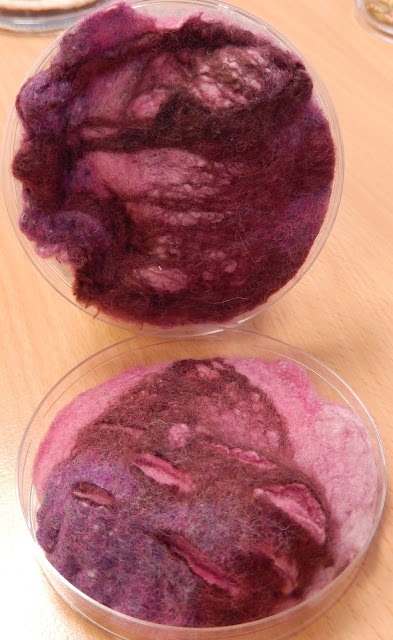Firstly, Margaret Walton again triumphed in the Challenge Cup, for which she received the trophy and a cheque for £50.
This is the second year running that Margaret has won the trophy, but the first time that she has been there to receive it!
Her piece of work was a beautiful book which she started making at the Branch's Frances Pickering workshop a few weeks ago. The judge said that it was "a really evocative piece about a journey through life".
It's got a little shoe attached too!
Julie Turner came second in the same competition, winning £25 for her piece, also a book, about the journey from sheep to clothing, entitled "Wool - A Back to Back Journey". Julie's book was stitched onto b;anklet "pages" and she used wool from her family's own prize-winning sheep.
This is a great picture of a naked sheep!
Another entry in this strongly contested category was from Abigail Ledder with her striking record of a journey to New Zealand.
Here's a close up of Abigail's beautifully stitched New Zealand silver fern leaf.
"Haere Mai" is Maori for "welcome".
Our final entry in the Challenge Cup was from Davina Adams with her journey round the world - this was also entered last week in the Branch's "Small World" challenge. The Russian Dolls all fit inside each other!
Moving on to the Maggie Judges Floral Trophy, which is presented in memory of our previous Regional Chair. Every year the flower begins with the next letter of the alphabet - this time it was E.
This year it was won by another Halifax member, Jenny Greenwood, with a white Echinacea appliquéd onto a black background.
There's even a bee stitched on there for good measure.
(The bee doesn't start with E).
Our other entry in the floral competition was again from Margaret Walton, with this beautiful Eryngium which includes feathers as part of the design.
No winners in the final class, the Coats-Anchor Award which this year was "Maps", but we still put on a good show!
This is a detail from Janice Townend's map of Windermere.
Here is another entry from Margaret (you can tell she's retired!) which is also based on the Lake District.
Closer to home for this entry from Anne Brooke :
And finally, Mandy's titchy map of the world.
Members will have to wait for the Regional Yearbook to come out to see photos of the other entries!
I think we can safely say that the flower next year is going to begin with the letter "F" - so get started on your freesias, fuchsias and fetter bushes!
In other news, Mandy won two prizes out of the 15 on offer in the Bag Raffle...not this one unfortunately, but here is Halifax's spectacular offering...thanks to all members who contributed, I can tell you that the lucky winner, who was from Ackworth Branch, was very pleased with her lovely prize!



















































